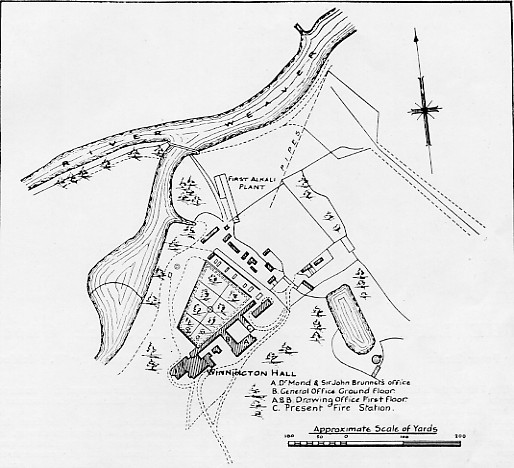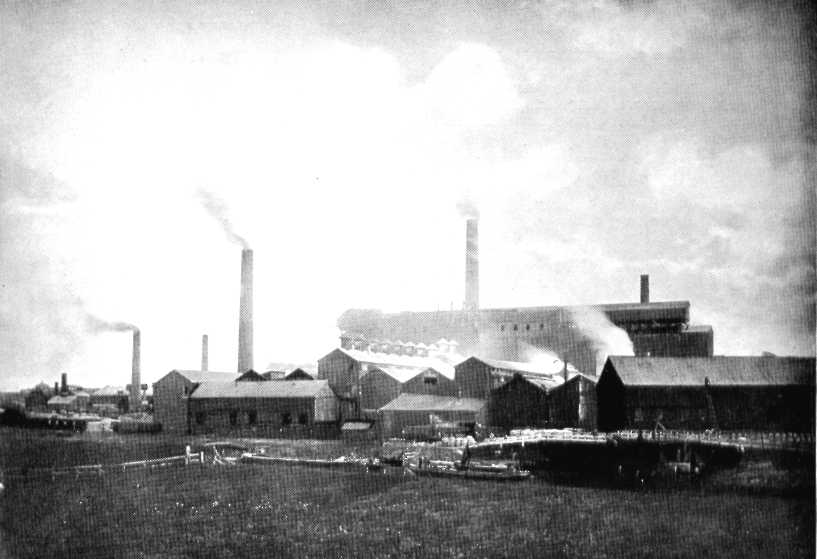 |
| Above: Winnington Works, eleven years old. The first plant is the second shed from the right. Right: Plan of Winnington Hall showing position of original works and offices, 1873-4. |
| A few descriptive words from former employees. First, in 1948, Mr John Astbury, retired Process Foreman:- "I came to the works in 1877 at the age of 13, to the Time Office. I was afterwards transferred to the Laboratory and as my school education had not included decimals I was compelled to study these at night school in order to be able to do the necessary work. At the same time I was carrying out tests such as the insoluble in ash by rule of thumb methods. |
| "The present [1948] railway line which circles round between the workshops and the end of the process buildings making a complete loop around the works was there from nearly the beginning, but as a single line with spurs as required. At the foot of the steps which leads from the end of the office directly down to the main roadway is the site of the original Time Office and nearby were the Laboratory and Smithy, all of them housed in what had been cow shippons on the Hall Estate. At the foot of the steps which leads from the end of the office directly down to the main roadway is the site of the original Time Office and nearby were the Laboratory and Smithy, all of them housed in what had been cow shippons on the Hall Estate. Farther up, approximately where the Drawing Office wing of the main office now ends, were other shippons used as a wheelwrights' shop and a cooperage. Beyond this, going on up the hill, was a pond in among the trees, and an icehouse. The Hall gardens were completely walled round with a ten foot brick wall. [The last parts of this wall were pulled down c.1946/7] Limestone came in by rail from Buxton and was discharged close to the Time Office in barrows, in which it was wheeled up the hill to a site about where the present Time Office is, where it had to be broken up by hand to a suitable size. The lumps were sometimes so large that it was difficult for one man to handle them in a barrow. There was a limestone stock at the top of the bank and the limestone was then further wheeled across a wodden trestle bridge straight to the top of the kilns which were situated close to the railway lines about where the end of the F.T.P. shop now is. The Milk-of-Lime Plant was down in the hole which has recently been filled in, by the now obsolete Grit Separating Plant. Beyond this, and across the loop line was the river bank which at that time was not piled or sheeted. Opposite, across the river, was the island meadow which had no building at all on it and in which it was possible in the autumn to gather mushrooms in the early hours of the morning." Horse drawn barges came up the river through a wooden swing bridge joining the island to the mainland and were discharged by plank gangways onto the bank. [See picture, top] In this way staves were brought in and carted to the cooperage and casks containing ammonia in the form of what was known as bone liquor were delivered. These were rolled up by hand and emptied into the vats. A common sight at the time would be men engaged in the above operations and others rolling down completed casks from the cooperage to the nearby ash packing points. One of the first steam driven boats put into service was designed as a tank barge for the ammonia liquor from Linacre. "The towpath at that time extended right along the island across the wooden bridge and along the front of the works away to Northwich and was a public right of way. Near this point, and on the river side of the loop line, there was some sort of brick built gas producer, but I am not quite sure what this was used for." And now Mr H. Yeomans, from a speech he gave c.1923:- "...It is now fifty years since the Firm was founded by the late Sir John Brunner amd Dr Mond, and when it had been in existence about eight years, I had just left school, and a consultation took place between my father and the then Mr Brunner and Mr Mond, as a result of which it was found desirable that I should link myself with the Firm. During the subsequent forty-two years, I and others of the old school have seen remarkable changes in every department ; .. I would like to name one or two of them, though, before doing so, I wish to say I had the priviledge of knowing the late Sir John Brunner and Dr Mond, and in those early days, when the firm was much smaller than it is today, naturally I was brought into closer contact with them. I frequently had to meet them in their offices, and they both had that happy manner which placed one at one's ease, and one left their presence feeling a better man for the conversation and intercourse. For the benefit of those younger members of the staff who have only been with us thirty years or so I would like to draw, in the fewest possible words, a sort of mental picture of the position as it was in those early days. The approach to the works, by Winnington Lane, was a country road. The village portion of Winnington Park consisted of eight houses in Dyar Terrace and twelve houses in Solvay road, and Solvay Road itself only existed as a cinder-road down to about where the Co-Operative Stores now stands. It then took a sharp turn to the right, and went over the fields to join another field road which ran down to a point near the stables. This was a very zig-zag approach, and the alternative was to go down Winnington Lane and enter by the lodge gates and cross the Park by the drive ; but the workmen did not use it very much, and preferred to climb over the fence near the Co-Operstive Stores and walk across the Park, making their own path." Until the Spring of 1875 all the firm's letters were in the hand of one or other of the Partners- more often than not that of Ludwig Mond. There are a few letters written in the neat, precise hand of Mrs Mond, showing that even she lent a hand when the Partners were busy down at the Works. Sir John never lost his interest in the office he founded and his deep personal concern for each individual employee is aptly illustrated by this extract from a speech by Mr Mackeral at the centenary of his birth. "Here is an incident, of which I was told only the other week, which occurred about 1896 or 1897. Sir John must have been staying at Winnington Hall at the time and seeing the lights on in the General Office about 9 o'clock at night he went in and found the Bookkeeping Department looing for 2d. to balance the Annual Accounts. He noticed the junior, a boy about 17 years of age, was there calling over the ledger postings and although at that date Sir John was Chairman of the Company, in view of the late hour he sent the boy home and took his place at the desk. I should have liked to be able to add that he discovered the 2d., but I understand the truth is that it was not found until the following morning. Brine Supplies The department of the Winnington Works responsible for brine and water supples became a fully fledged Works in May, 1948. In the early days, brine supplies were precarious, since Lord Stanley's main served several salt works. Many altercations took place between Dr Mond and the local salt works Managers and the tale is told that on one occasion Dr Mond sat on a valve for a whole day to prevent a Mr Lockie from taking all the brine for his salt works. In 1878 however, two brine shafts were sunk in the south-eastern corner of the park, close to the railway line, thus providing an independent supply. |
| * |
 |
| * |
Winnington Works |